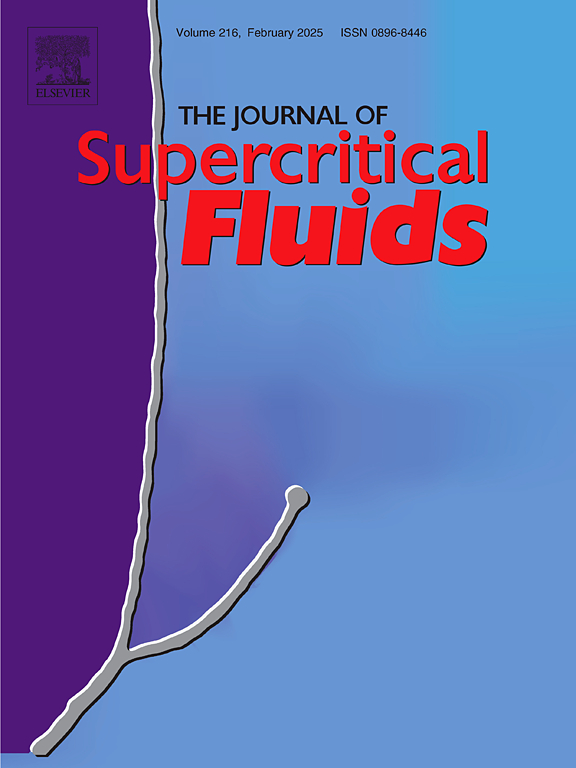Prediction of the solid solubility of anthraquinone derivatives in supercritical CO2 from the molecular structure and melting temperature by the solution model approach
IF 4.4
3区 工程技术
Q2 CHEMISTRY, PHYSICAL
引用次数: 0
Abstract
Solubility estimations and understandings are crucial tasks for designing and developing supercritical fluid technology. This study aims to develop an approach to predict the solid solubility in supercritical CO2 for a class of structure-related compounds, anthraquinone derivatives (AQDs), by using only the molecular structure and melting temperature. A regular solution model coupled with the Flory-Huggins equation was used to generalize the total 1362 solid solubility data of 28 AQDs in supercritical CO2. By the developed model, the solubility behavior can be predicted successfully within order consistency with an average absolute logarithmic deviation (AALD) of 0.439. To demonstrate the extrapolation ability of the model, new solid solubility data of an AQD, 1,5-diaminoanthraquinone, in supercritical CO2 were measured, and the experimental solubilities could be predicted to be order-consistent with AALD of 0.453. In addition, the robustness of the solution model approach was confirmed by building different tests, even in an extreme case, using only 2 % of the data (28/1362) for model generalization. In summary, only by using the molecular structure and melting temperature, the developed solution model is efficient for solubility prediction within order consistency and shows excellent extrapolation ability for screening and designing new AQD molecules for supercritical fluid applications.
用溶液模型法从分子结构和熔融温度预测蒽醌衍生物在超临界CO2中的固溶度
溶解度的估计和理解是设计和发展超临界流体技术的关键任务。本研究旨在建立一种仅利用分子结构和熔融温度预测一类结构相关化合物蒽醌衍生物(AQDs)在超临界CO2中的固溶度的方法。采用正则溶液模型结合Flory-Huggins方程对28种AQDs在超临界CO2中的1362个固溶数据进行了推广。利用所建立的模型,可以成功地预测溶解度行为,其平均绝对对数偏差(AALD)为0.439,在序一致性范围内。为了验证该模型的外推能力,我们测量了一种AQD 1,5-二氨基蒽醌在超临界CO2中的溶解度数据,并预测了实验溶解度与AALD 0.453的顺序一致。此外,通过构建不同的测试,即使在极端情况下,仅使用2 %的数据(28/1362)进行模型泛化,也证实了解模型方法的鲁棒性。综上所述,仅利用分子结构和熔融温度,所建立的溶液模型就能有效地进行序一致性范围内的溶解度预测,并在筛选和设计用于超临界流体的新型AQD分子方面显示出良好的外推能力。
本文章由计算机程序翻译,如有差异,请以英文原文为准。
求助全文
约1分钟内获得全文
求助全文
来源期刊

Journal of Supercritical Fluids
工程技术-工程:化工
CiteScore
7.60
自引率
10.30%
发文量
236
审稿时长
56 days
期刊介绍:
The Journal of Supercritical Fluids is an international journal devoted to the fundamental and applied aspects of supercritical fluids and processes. Its aim is to provide a focused platform for academic and industrial researchers to report their findings and to have ready access to the advances in this rapidly growing field. Its coverage is multidisciplinary and includes both basic and applied topics.
Thermodynamics and phase equilibria, reaction kinetics and rate processes, thermal and transport properties, and all topics related to processing such as separations (extraction, fractionation, purification, chromatography) nucleation and impregnation are within the scope. Accounts of specific engineering applications such as those encountered in food, fuel, natural products, minerals, pharmaceuticals and polymer industries are included. Topics related to high pressure equipment design, analytical techniques, sensors, and process control methodologies are also within the scope of the journal.
 求助内容:
求助内容: 应助结果提醒方式:
应助结果提醒方式:


